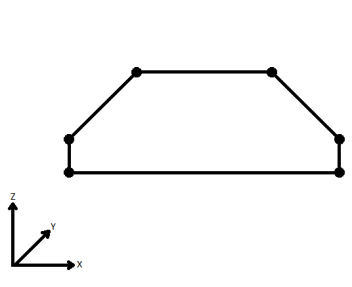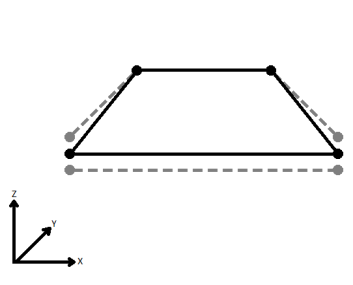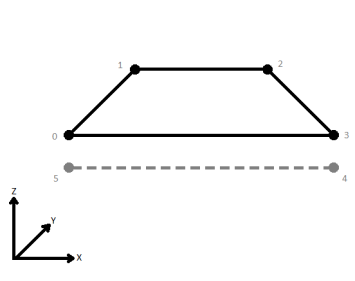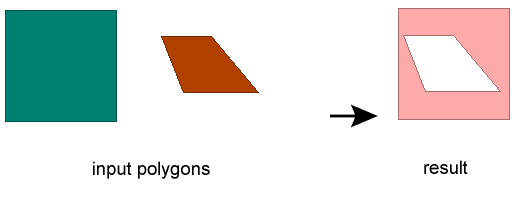Cuts holes in polygonal features by making polygons completely enclosed in other polygons into holes of the containing polygon.
The DonutBuilder assumes that the input area features are topologically clean. Further, it is assumed that any two input polygons within a group either have a strict containment relationship, or are not overlapping.
Aggregate features are decomposed recursively to their components and non-area features will be output via the <Rejected> port.
Output Ports
The resulting donut and hole features will be output through this port.
Features with non-area or null geometry will be output through this port.
Rejected features will have an fme_rejection_code attribute with the value INVALID_GEOMETRY_TYPE.
Parameters
Transformer
The default behavior is to use the entire set of input features as the group. This option allows you to select attributes that define which groups to form. Each set of features which have the same value for all of these attributes will be processed as an independent group.
Process At End (Blocking): This is the default behavior. Processing will only occur in this transformer once all input is present.
Process When Group Changes (Advanced): This transformer will process input groups in order. Changes of the value of the Group By parameter on the input stream will trigger processing on the currently accumulating group. This may improve overall speed (particularly with multiple, equally-sized groups), but could cause undesired behavior if input groups are not truly ordered.
There are two typical reasons for using Process When Group Changes (Advanced) . The first is incoming data that is intended to be processed in groups (and is already so ordered). In this case, the structure dictates Group By usage - not performance considerations.
The second possible reason is potential performance gains.
Performance gains are most likely when the data is already sorted (or read using a SQL ORDER BY statement) since less work is required of FME. If the data needs ordering, it can be sorted in the workspace (though the added processing overhead may negate any gains).
Sorting becomes more difficult according to the number of data streams. Multiple streams of data could be almost impossible to sort into the correct order, since all features matching a Group By value need to arrive before any features (of any feature type or dataset) belonging to the next group. In this case, using Group By with Process At End (Blocking) may be the equivalent and simpler approach.
Note: Multiple feature types and features from multiple datasets will not generally naturally occur in the correct order.
As with many scenarios, testing different approaches in your workspace with your data is the only definitive way to identify performance gains.
Parameters
When viewed in 2D (ignoring Z), a path (which may define the border of a polygon) may appear to be closed as shown in the left figure below. This same path, when viewed in 3D, may appear to be open as shown in the right figure below.

To specify how (and if) paths should be closed in 3D, select one of the listed modes.
| Mode | Description | Example |
|---|---|---|
| Extend | The Curve is extended so that all vertices are left at their original location. |

|
| Average | Subsequent vertices that are not connected, but share an x and a y value are combined into one vertex, whose Z value is the average of the original two. |

|
| First Wins | Subsequent vertices that are not connected, but share an x and a y value are combined into one vertex, whose Z value is taken from the first encountered vertex. |

|
| Last Wins | Subsequent vertices that are not connected, but share an x and a y value are combined into one vertex, whose Z value is taken from the last encountered vertex. |

|
| Ignore | Z values are ignored. No change is made to the way the nodes are connected. |

|
The Drop Holes parameter indicates whether or not features used to cut holes in containing features should themselves be dropped or output.
This parameter will be added to each output feature and will contain "yes" if that feature was used to cut a hole into some containing feature, and "no" if that feature was not used as a hole.
Area features may be considered in groups based on the value of one or more attributes. Only features in the same group are then considered for hole nesting.
Preserve Internal Edges (for advanced FME users) specifies that coordinate "cycles" within a polygon are allowable and will be preserved. A "cycle" is a line segment that occurs twice in the same polygon's boundary (once in each direction).
Attribute Accumulation
If Merge Hole is chosen, attributes from all features will be merged, and in case of conflicts, the value of the Conflict Resolution parameter will be used. If Prefix Hole is chosen, then all hole attributes will be presented with a prefix set in the Prefix parameter. If Only Use Hole is chosen, only attributes from hole features will be used.
This parameter is enabled when Accumulation Mode is set to Merge Hole. Use Outer Shell and Use Hole will give priority to outer shells and holes respectively in case of attribute conflicts.
The value is used as a prefix for hole attributes when Accumulation Mode is Prefix Hole.
If you specify a Hole List Name, a list will be created on each output donut containing an element for each input feature that became a hole, in the order that the holes appear on the donut.
Note: List attributes are not accessible from the output schema in Workbench unless they are first processed using a transformer that operates on them, such as ListExploder or ListConcatenator. Alternatively, AttributeExposer can be used.
Example

Editing Transformer Parameters
Using a set of menu options, transformer parameters can be assigned by referencing other elements in the workspace. More advanced functions, such as an advanced editor and an arithmetic editor, are also available in some transformers. To access a menu of these options, click  beside the applicable parameter. For more information, see Transformer Parameter Menu Options.
beside the applicable parameter. For more information, see Transformer Parameter Menu Options.
Transformer Categories
Search FME Community
Search for samples and information about this transformer on the FME Community.
Keywords: island Donutizer